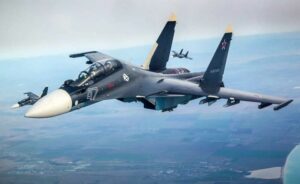The Sukhoi Su-30, an advanced twin-engine, multirole fighter aircraft developed by Russia’s Sukhoi Aviation Corporation, stands as a testament to cutting-edge aeronautical engineering. Known for its exceptional versatility, impressive maneuverability, and formidable arsenal, the Su-30 has cemented its place as a cornerstone in modern air combat. This article delves into the fascinating aspects of the Su-30, exploring its development, capabilities, and the strategic role it plays in various air forces worldwide.

Development and Evolution
The Su-30’s origins trace back to the Sukhoi Su-27, a renowned air superiority fighter. Building on the success of the Su-27, Sukhoi embarked on developing a more versatile variant capable of performing a broader range of missions. The Su-30 emerged as a result, incorporating advanced avionics, enhanced weapon systems, and the ability to perform air-to-air, air-to-ground, and reconnaissance missions.
One of the key milestones in the Su-30’s evolution was the development of the Su-30MKI variant for the Indian Air Force. This collaboration between Sukhoi and India’s Hindustan Aeronautics Limited (HAL) resulted in a highly advanced version equipped with thrust-vectoring engines, a digital fly-by-wire system, and a state-of-the-art radar. The success of the Su-30MKI paved the way for further variants tailored to the specific needs of other nations, such as the Su-30MKK for China and the Su-30SM for Russia.

Capabilities and Performance
The Su-30’s versatility is one of its defining features. It can carry out a wide range of missions, from air superiority and ground attack to maritime strike and electronic warfare. Equipped with two powerful AL-31F afterburning turbofan engines, the Su-30 boasts a top speed of Mach 2 and a combat range of over 3,000 kilometers. This enables it to operate effectively in various theaters of combat, providing a significant strategic advantage.
One of the standout capabilities of the Su-30 is its exceptional maneuverability. The aircraft’s thrust-vectoring nozzles allow it to perform complex aerial maneuvers, such as the Pugachev’s Cobra and the Kulbit, which are beyond the capabilities of conventional fighters. This high level of agility, combined with an advanced fly-by-wire system, provides the Su-30 with a decisive edge in dogfights and close-quarters combat.
The Su-30’s avionics suite is equally impressive. It features the N011M Bars radar, which offers a detection range of up to 400 kilometers and the ability to track multiple targets simultaneously. The aircraft is also equipped with an advanced electronic warfare system, providing enhanced survivability against enemy radar and missile threats. Additionally, the Su-30’s cockpit is designed for high situational awareness, with multifunctional displays and a heads-up display (HUD) providing critical information to the pilot in real time.

Armament and Payload
The Su-30’s formidable arsenal includes a wide range of air-to-air and air-to-ground missiles, bombs, and rockets. It is capable of carrying up to 8,000 kilograms of ordnance across twelve hardpoints, making it a highly flexible platform for various mission profiles. For air-to-air combat, the Su-30 can be armed with R-77 and R-27 missiles, providing it with excellent beyond-visual-range (BVR) engagement capabilities.
In the ground attack role, the Su-30 can deploy a variety of precision-guided munitions, such as the Kh-29 air-to-surface missile and the KAB-500 guided bomb. Additionally, the aircraft is equipped with a 30mm GSh-30-1 cannon for close-in engagements, further enhancing its lethality.

Global Presence and Strategic Impact
The Su-30’s impressive capabilities have led to its widespread adoption by air forces around the world. Countries such as India, China, Malaysia, and Algeria operate variants of the Su-30, leveraging its multirole capabilities to bolster their air defense and strike capabilities. The aircraft’s versatility makes it a valuable asset in both defensive and offensive operations, capable of adapting to various mission requirements.
In India, the Su-30MKI plays a crucial role in maintaining air superiority and conducting precision strikes. Its integration with indigenous systems and weapons has further enhanced its operational effectiveness. Similarly, in China, the Su-30MKK serves as a key component of the People’s Liberation Army Air Force (PLAAF), providing robust air defense and strike capabilities.
Conclusion
The Sukhoi Su-30 represents a pinnacle of modern fighter aircraft design, combining advanced technology, exceptional performance, and unparalleled versatility. Its ability to perform a wide range of missions with high effectiveness makes it a formidable asset in any air force’s arsenal. As global security dynamics continue to evolve, the Su-30’s strategic importance is likely to grow, solidifying its place as one of the most influential multirole fighters of the 21st century.





